Remembering Vittorio Gregotti: architect, thinker, Italian
We celebrate the legacy of intellectual Italian architect Vittorio Gregotti

Over the weekend articles and streamed reports tried to ease the grief caused by the great loss of Vittorio Gregotti, who passed away aged 92 on 15 March, in Milan.
Gregotti was the archetype of the intellectual architect, a typically Italian figure that, from the 1960s, fused the profession with political militancy. He obstinately insisted that his work should be socially useful – both a guide and a service to the community. He took full responsibility for his actions, creating a highly cultured vision of the built world. It will take time to absorb the full complexity of this intellectual, whose work is so important for both Italian and international architecture.
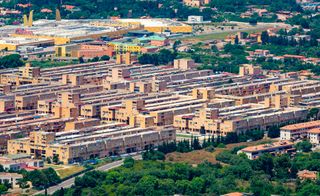
Palermo ZEN neighbourhood, designed by Gregotti
Many of his most important treatises such as ‘The Architecture of the Land’ (‘Lâ architettura del territorioâ', Feltrinelli, 1966) have never been translated into English. For him, architecture was first and foremost a cultural phenomenon, an artistic practice based on the critical observation of the real world that can be applied to an area to improve it socially. He designed cities and buildings in Italy, China, Portugal, Germany and Morocco.
There is no kind of building that Gregotti did not design, so wide was his range, but they all had one thing in common: the ties to their contexts, to the decisive intervention on the landscape. Gregotti was a famous city planner, a prolific writer, editor and then director of Casabella magazine, university lecturer in Milan, Venice and Palermo, together with his friend Umberto Eco he was the curator of an unforgettable Triennale di Milano in 1964, all about ‘free time'. He was a great draftsman and made the conscious decision not to embrace digital culture.

Cover of Casabella, N. 501, April 1984, Arnoldo Mondadori Editore. The drawing depicts the Olympic Ring of Barcelona; the work, drawn and coloured in pastel by Gregotti Associates studio, represents the esplanade of Montjuic, where the Olympic facilities for the possible Games in 1992 are foreseen. The facilities include a sports hall in the first floor, a large multi-purpose stadium more in the background, and other facilities next to them, in a compact and rather quadrangular structure; in the background stands out the coastline and the sea.
At the beginning of his career, he also designed products, joining forces with Giotto Stoppino and Ludovico Meneghetti. He believed that industrial design was a discipline dedicated to the life of human beings and not to style, consumerism or brands, writing a fundamental manual on ‘Design of the Industrial Product. Italy 1860-1980', (‘Il disegno del prodotto industriale. Italia 1860-1980', Electa). This work is above all interesting for its precise definition of design as a mechanical and aesthetic strategy for realising objects, and not as a phenomenon that is subject to fads and trends.
He was director of the Visual Arts section of the Venice Biennale just after the youth protests of the early 1970s and, following his intuition, introduced the subject of space to the show – a concept that was being enthusiastically explored by artists of the time. Franco Raggi, Germano Celant and Luca Ronconi contributed to the same vision. Just two years ago, in 2018, the Padiglione d'Arte Contemporanea (PAC) in Milan, dedicated a vast retrospective show to his life and work, curated by Guido Morpurgo. Present at the inauguration of the exhibition were some of the figures that shared Gregotti's unique professional journey such as the product and graphic designer Pierluigi Cerri, the curator and writer Pierluigi Nicolin and the architect Augusto Cagnardi.

Kaleidoscope, Xiii Triennale di Milano, 1964, which Gregotti curated alongside Umberto Eco
During those days I passed by via Matteo Bandello in Milan, historic home of Gregotti Associati studio, in the company of Stefano Boeri, architect and president of the Triennale di Milano. He told me that that studio ‘was the first in Milan to be a cosmopolitan place, a platform for collective thinking, open to the architectural cultures and philosophies of Japan, Portugal, China, and connected to the literary and musical culture of Venice and Paris, to all of which Vittorio Gregotti had been a great orchestral conductor'.
Gregotti passed away of pneumonia, after contracting the novel coronavirus, Covid-19. The Milanese community takes up his cultural heritage and will continue to express it while respecting those who, today, mourn the loss of a figure. Due to current government regulations, no public commemorative service has been planned.

Sant Jordi Sports Palace, at the Olympic Installation designed by Gregotti in Barcelona in October, 1991.
Wallpaper* Newsletter
Receive our daily digest of inspiration, escapism and design stories from around the world direct to your inbox.
-
 Tech Editor, Jonathan Bell, selects six new and notable Bluetooth speaker designs, big, small and illuminating
Tech Editor, Jonathan Bell, selects six new and notable Bluetooth speaker designs, big, small and illuminatingThese six wireless speakers signal new creative partnerships and innovative tech approaches in a variety of scales and styles
By Jonathan Bell Published
-
 As London’s V&A spotlights Mughal-era design, Santi Jewels tells of its enduring relevance
As London’s V&A spotlights Mughal-era design, Santi Jewels tells of its enduring relevance‘The Great Mughals: Art, Architecture and Opulence’ is about to open at London’s V&A. Here, Mughal jewellery expert and Santi Jewels founder Krishna Choudhary tells us of the influence the dynasty holds today
By Hannah Silver Published
-
 London bar Bauhaus Warehaus is a factory by day, drinking den by night
London bar Bauhaus Warehaus is a factory by day, drinking den by nightMixologist of the moment Remy Savage shakes up the world of cocktail-making with a hardworking sibling to A Bar with Shapes for a Name, his Bauhaus-inspired bar enterprise in east London
By Neil Ridley Published
-
 A floor made of tomato skins? Welcome to the Mutti Canteen by Carlo Ratti in Parma
A floor made of tomato skins? Welcome to the Mutti Canteen by Carlo Ratti in ParmaMutti Canteen by Carlo Ratti is a new, environmentally friendly foodie piece of architecture within Parma's green countryside
By Ellie Stathaki Published
-
 Remembering Christopher Charles Benninger (1942-2024)
Remembering Christopher Charles Benninger (1942-2024)Architect Christopher Charles Benninger has died in Pune, India, at the age of 82; we honour and reflect on his passing
By Aastha D Published
-
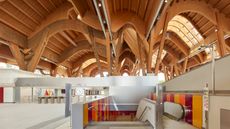 Naples Central Station boasts a wavy, wooden signature roof that is dramatic and sculptural
Naples Central Station boasts a wavy, wooden signature roof that is dramatic and sculpturalNaples Underground Central Station by Benedetta Tagliabue is a work of art that’s inviting and vibrant, matching its dynamic context
By Ellie Stathaki Published
-
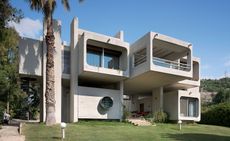 Remembering Alexandros Tombazis (1939-2024), and the Metabolist architecture of this 1970s eco-pioneer
Remembering Alexandros Tombazis (1939-2024), and the Metabolist architecture of this 1970s eco-pioneerBack in September 2010 (W*138), we explored the legacy and history of Greek architect Alexandros Tombazis, who this month celebrates his 80th birthday.
By Ellie Stathaki Published
-
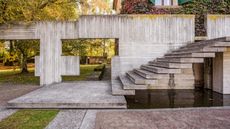 ‘Carlo Scarpa: The Complete Buildings’ is an essential tour of the Italian master’s works
‘Carlo Scarpa: The Complete Buildings’ is an essential tour of the Italian master’s works‘Carlo Scarpa: The Complete Buildings’ is the perfect book for architecture enthusiasts
By Jonathan Bell Published
-
 New Aesop Milan store is a haven of beauty and tranquillity
New Aesop Milan store is a haven of beauty and tranquillityThe latest Aesop Milan store to open is a hub of wellness, beauty and tranquillity in the Italian metropolis
By Ellie Stathaki Published
-
 A new water mirror casts a misty veil over ancient Roman baths
A new water mirror casts a misty veil over ancient Roman bathsArchitect Hannes Peer reveals a water mirror in Rome – an immersive architectural installation at the heart of the ancient Baths of Caracalla
By Ellie Stathaki Published
-
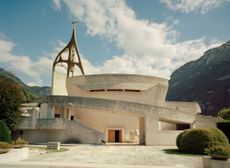 Giovanni Michelucci’s dramatic concrete church in the Italian Dolomites
Giovanni Michelucci’s dramatic concrete church in the Italian DolomitesGiovanni Michelucci’s concrete Church of Santa Maria Immacolata in the Italian Dolomites is a reverently uplifting memorial to the victims of a local disaster
By Jonathan Glancey Published